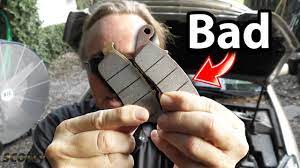The brakes on your vehicle are one of the most important features. They are a bit complex, but understanding how they work and what signs to look for will go a long way toward keeping them in top working order. The brake system is made up of a few key components that all work together to stop your vehicle.
Six Signs to Watch For
Most of us have probably experienced clunking brakes once or twice, if not more. It’s a frustrating and sometimes dangerous feeling when the brakes are hard to pedal, the pedal seems stuck in the floorboard and you’re jostled from side to side as you attempt to stop. But it could also mean your brake pads need changing. So how do you know?
Here are some tips on spotting what’s wrong:
Sounds
If you hear noise when you apply the brakes, the first thing to do is take a look at where the noise is coming from. If it’s a loud screeching sound, chances are that your brake pads have worn too low and need replacement. On the other hand, if it’s a heavy grinding sound, then this likely means your brake rotors or drums are wearing or have worn out.
If the brake pads are worn too low, they begin to make constant squealing or grinding sounds when pressed. In older cars, this may not be such an issue since metallic brakes were standard—but modern cars now use ceramic brakes which can cause serious damage if left without being replaced for long periods of time. Do not ignore such noises and get your car to a mechanic immediately!
Another common noise type is humming or clicking sounds. This may indicate that there is some loose hardware somewhere within the braking system which needs tightening up as soon as possible before it falls off completely and causes further damage to your vehicle’s braking system.
Physical Feelings
- Brakes pulsate when your brake rotors are worn down or warped. the pulsation can feel like the pedal is moving up and down, similar to a bouncing ball. This can occur at high speeds when your brakes are applied for an extended period of time.
- If you apply pressure to the brake pedal and it feels soft or spongy, there may be air in your brake lines which causes a loss of pressure and results in a longer stopping distance.
- The opposite can also be true; if you push down on your brake pedal but it feels hard or stiff, this could indicate that there is something in the way of your brake pads and rotors such as rust or debris. The solution to these issues will vary depending on their severity so it’s important to have them checked out by a certified mechanic as soon as possible!
Vehicle Response
A vehicle in need of brake repair can exhibit symptoms such as:
- pulling to one side of the road
- not stopping straight
- drifting forward when stopped
- making sudden stops
- not stopping in time
- not stopping at all.
Also, the ABS (anti-lock braking system) light may come on and a pulsing feeling may be felt through the brake pedal when braking. The brakes are literally too bad to stop the car.
Dashboard Indications
Warning lights are a great indicator that your brakes may need to be checked out. When you first start your car be sure to pay attention to any warning lights that appear on the dash. If you notice any messages come up that say “service brake system” or “low-level brake fluid” it is a good indication that there might be something wrong with your brakes. Other warning lights include ABS or brake warning lights, both of which indicate an issue with the braking system. This is why it is important to know what every light on your dashboard means so you can accurately assess if and when your car needs maintenance work.
Brake Pedal Behavior
A good rule of thumb is that if the brake pedal feels or behaves in any way that is out of the ordinary, you should get it checked out. If you notice any of the following, it’s time to call a mechanic:
- The pedal is hard to press
- The pedal feels spongy
- The pedal is low to the floor
- The pedal pulses up and down when you apply it
- When applying the brakes, your vehicle pulls to one side or another (this may indicate more than just bad brakes)
Visual Cues
While driving, take a look at the brake pads. If they are worn down to less than ¼ of an inch, it’s time to replace them. Another sign that you might need new brakes is discoloration or corrosion on your brake disc from the brake pads wearing down.
If you notice any brake fluid leaks underneath your car, this may mean that your fluid lines are rusty and rusted. Check your brakes for damage or loose connections to make sure air isn’t getting trapped in them before going on with any other repairs.
If you see a warning light on the dashboard indicating that something is wrong with the braking system, take this as a sign there could be some issue with your brakes and have them checked out by an auto mechanic immediately.
Check the levels in your brake fluid reservoir regularly and keep an eye out for signs of leakage around where it connects to the master cylinder under hood when topping off fluids during routine maintenance checks too – if either area looks suspiciously low or has visibly darkened over time (brake fluid goes bad quicker than most other car components), get it serviced before operating vehicle further
You need to know how to spot brake trouble.
- Thickness of brake pads
- Spongy feeling when you apply the brakes
- Grinding or squealing noises
- Vibration coming from your brake pedal

